Birmingham City Women have one of the best organised squads in the WSL, despite sitting second from bottom when the league was postponed. One of those who ensures this balance is Scotland midfielder Chloe Arthur. She tends to play as one of the two central midfielders, along with England’s Lucy Staniforth, but as the more defensively-minded one. This tactical analysis will look at how Arthur is central to how Birmingham City play, and the scout report will look at how their attack is benefited by her positioning and spatial awareness. We will also look at how all of this helps her to make some good passes, which helps Birmingham’s tactics, but also how she could improve her passing for future games.
The three points we will look at in this analysis all influence each other in turn, and so we will look at each one in a specific order. Firstly, we will analyse Arthur’s spatial awareness.
Her spatial awareness
With this, what we can say is that Arthur has an instinct for seeing where the space is on the pitch, and moving to occupy that space. The image below demonstrates this idea.
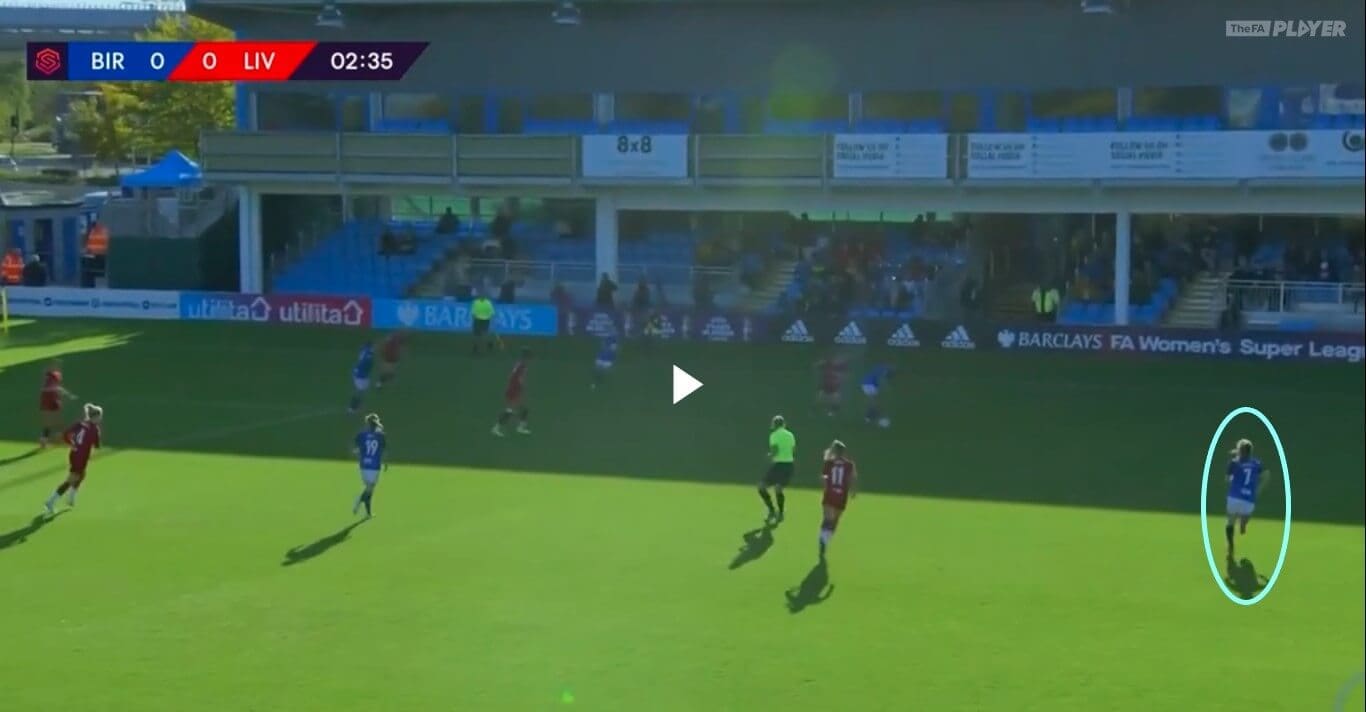
What we can see is that Chloe Arthur has noticed that the Liverpool Women defenders have focused entirely on the Birmingham forward line, consisting of Lucy Whipp, Rachel Williams and Abbi Grant. Lucy Staniforth is also in an advanced position. Arthur has seen that there is space behind the attack, and is now offering herself as a passing option for her teammate. This is especially important because of the congestion that has occurred where the ball is in the above image.
Also notice Arthur’s body position; she is facing the ball, which means she can control the ball easily and then move it on, ensuring that the space she has created with her spatial awareness has not been wasted.
Another, perhaps more evident example of Arthur’s spatial awareness is shown below.
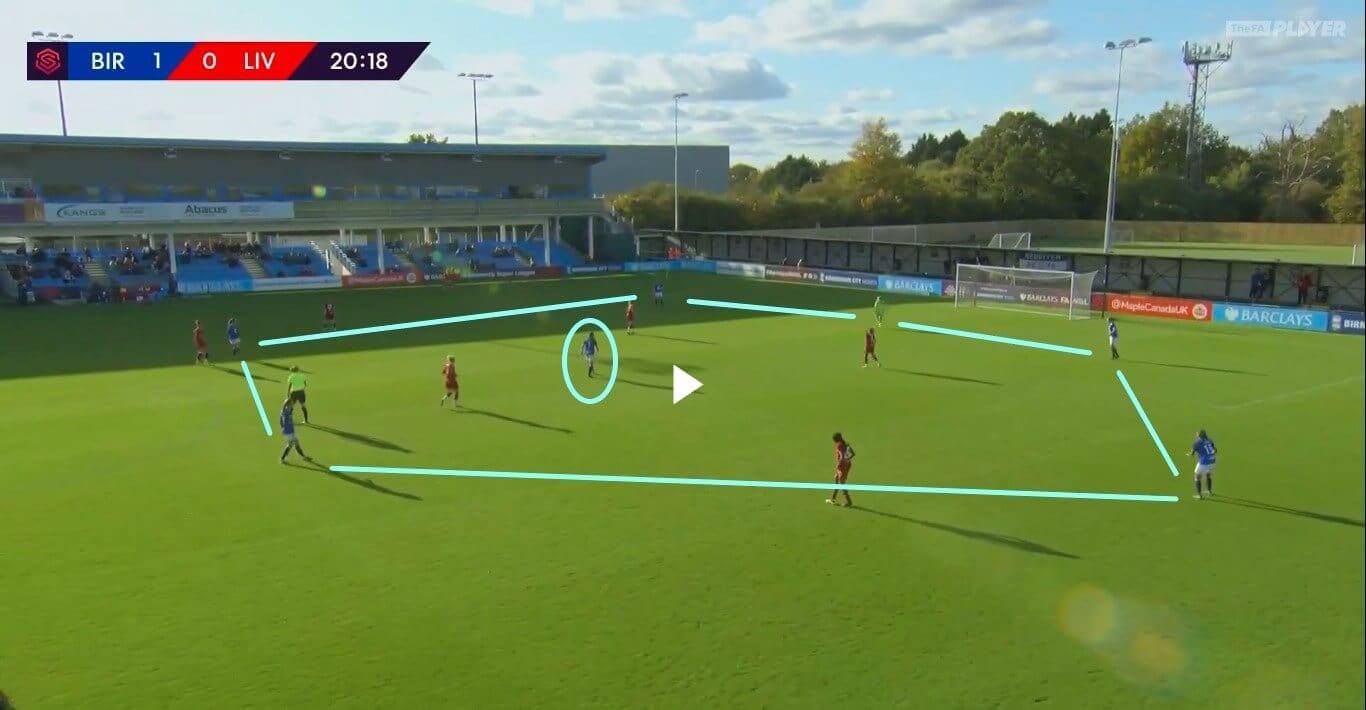
In this example, we can see how Birmingham City Women have formed an outer perimeter in their defensive tactics, including the goalkeeper Hannah Hampton, and this would normally have enabled Liverpool Women to have moved wide to cover as many of the Blues’ players as possible. However, you can also see how Chloe Arthur has seen this, and has moved into the middle of the space, which does two things.
Firstly, for her team, it creates a passing option and a link between each player, as they try to move the ball into the clear. Secondly, for Liverpool, it forces them to not move as wide as they might have done initially, because they have to consider the threat that Arthur now poses by being in the centre of the shape.
To explain this second idea further, if Birmingham had formed this shape, and not had any player in the middle, then Liverpool’s attack would have just positioned themselves next to as many of the Blues’ players as possible. This would have meant that, when Birmingham tried to move the ball around and into space, there would have been an increased chance that Liverpool would have been able to take it off them via an interception.
However, because Chloe Arthur has moved into that space, now Liverpool’s attack has two things to do; mark the outer ring, but also mark Arthur, so that the ball doesn’t reach her in the space that has been created. What has been done by Birmingham, therefore, is very clever, because Liverpool Women are now in two minds about who should be marked. Inevitably this leads to gaps being created, and this has all come about because Chloe Arthur saw the space in the middle and moved into it, thus highlighting her excellent spatial awareness.
The final example of this is in the next image.
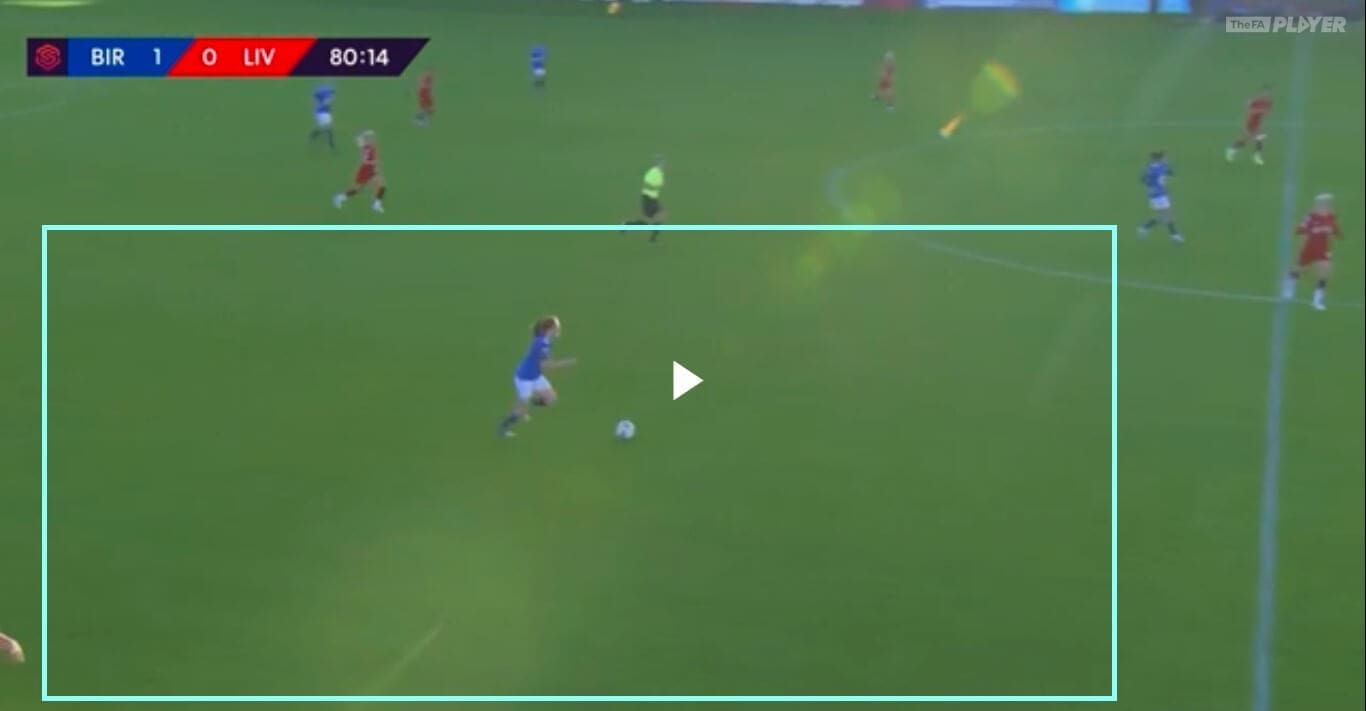
You can see how Chloe Arthur is positioned in space again, with the ball in her possession, and she is able to advance forwards with ease due to the lack of pressure put on her by the defence. The square she is in demonstrates this.
There is nothing really to add from this image, other than that it brings what we have seen in the other examples together. She has found space, and has been given the ball in that area (much like the first image we saw), and the defenders are unsure whether to close her or her options down, for fear of creating gaps elsewhere on the pitch (much like the second example).
What we can say from this section of the scout report, therefore, is that Chloe Arthur’s spatial awareness is something that really benefits her and her team’s playing style. Now we will take this tactical analysis further by analysing how her spatial awareness helps her positioning on the pitch.
Her positioning
The first thing to mention about this is that Birmingham City Women play with attacking full-backs, mainly Sarah Mayling and Adrienne Jordan, and this means that sometimes the two centre-backs are left without assistance, should opponents make a counter-attacking move. Below, you can see how Chloe Arthur’s role as a defensive-minded midfielder ensures she fulfils this role.
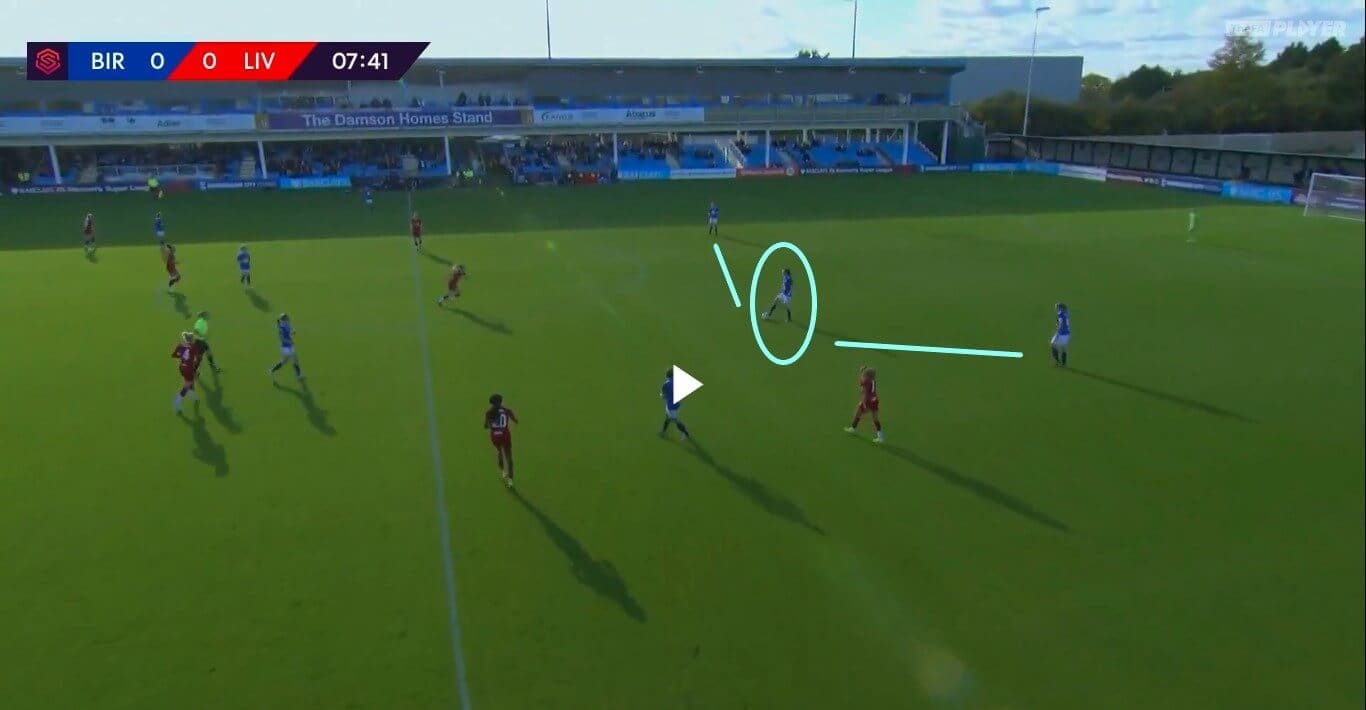
What we can see is exactly what has been described above, in that centre-backs Rebecca Holloway and captain Kerys Harrop have been left at the back. Arthur has moved back to help them out, forming a back three. This directly helps Birmingham’s attack, because with Mayling and Jordan able to get further forward, Birmingham have more players available to attack with. This is another way that Arthur’s positioning helps Birmingham’s tactics.
As we move back to look at Arthur’s positioning as a midfielder, we can see something similar to when we looked at Arthur in the middle of the Birmingham defence’s circle in the first section of the scout report.
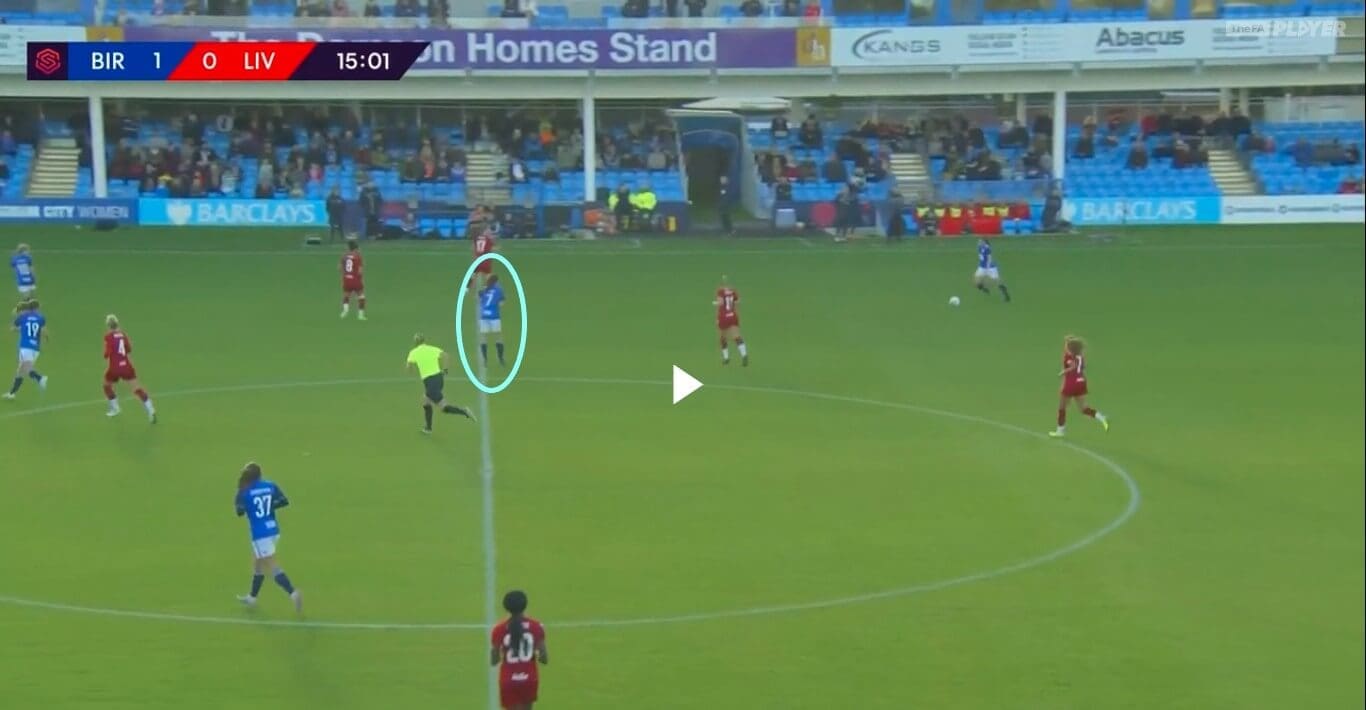
What is happening here is that Arthur, circled, has taken up a position in the middle of the pitch, and is acting as a link between the defence and attack. She likes to play in this box-to-box role, and it is one of her best strengths.
To look more closely at the image, we can see how Birmingham City Women have the ball in defence, moving forwards, and the attack is in the opposite half, with Liverpool players ready to pounce on any pass in between them. However, Chloe Arthur has moved to bridge the gap, and now Birmingham have a way of playing through the Liverpool players, to shift the ball from defence to attack. So, again, what we can see is that Arthur’s spatial awareness has helped her to get in the right position, in order to ensure she can help her team to get the ball forwards.
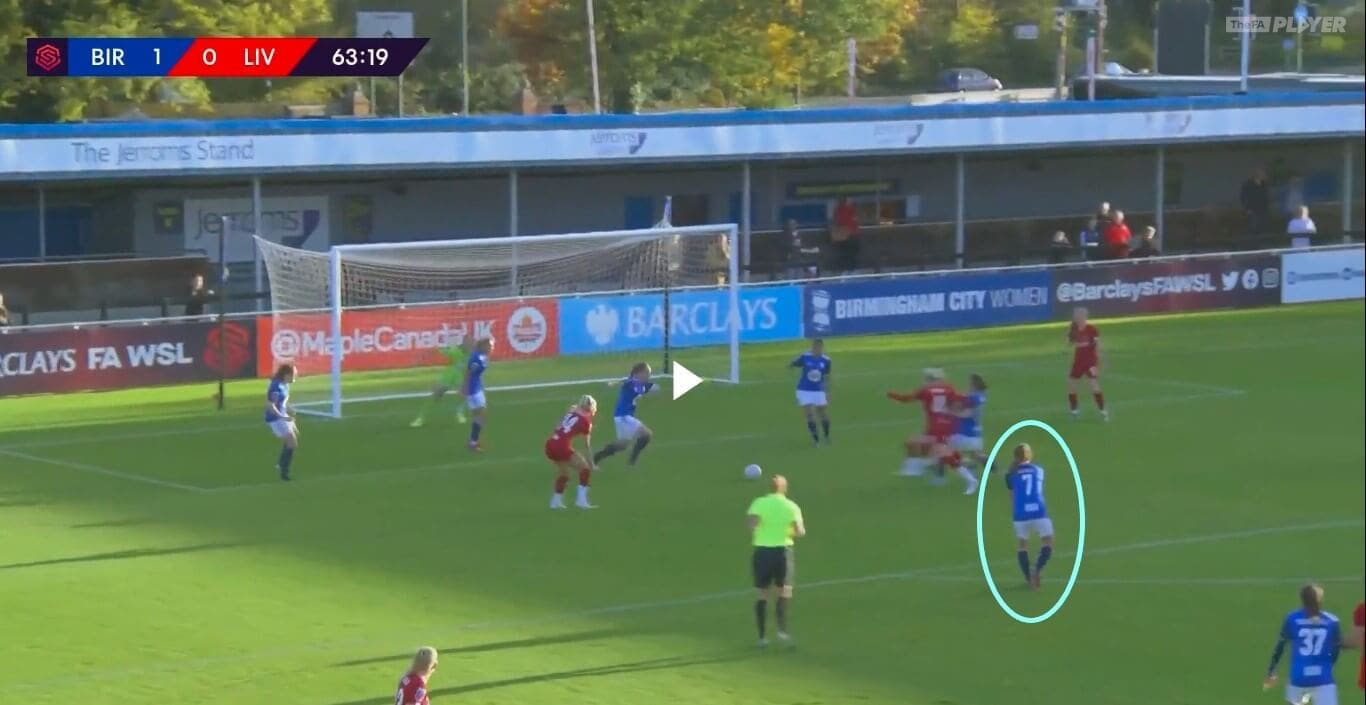
In this image, we can see another aspect of Arthur’s positioning. In this example, Birmingham are in attack, and Arthur has taken up a position just outside the goal area. We can see how there are five Birmingham players in the area, and so it has become quite congested, so Arthur is offering herself as a passing option, and this has been a recurring theme throughout this tactical analysis so far. Her spatial awareness allows her to get into good areas, and this helps Birmingham’s style of play.
The final example in this section is shown below.
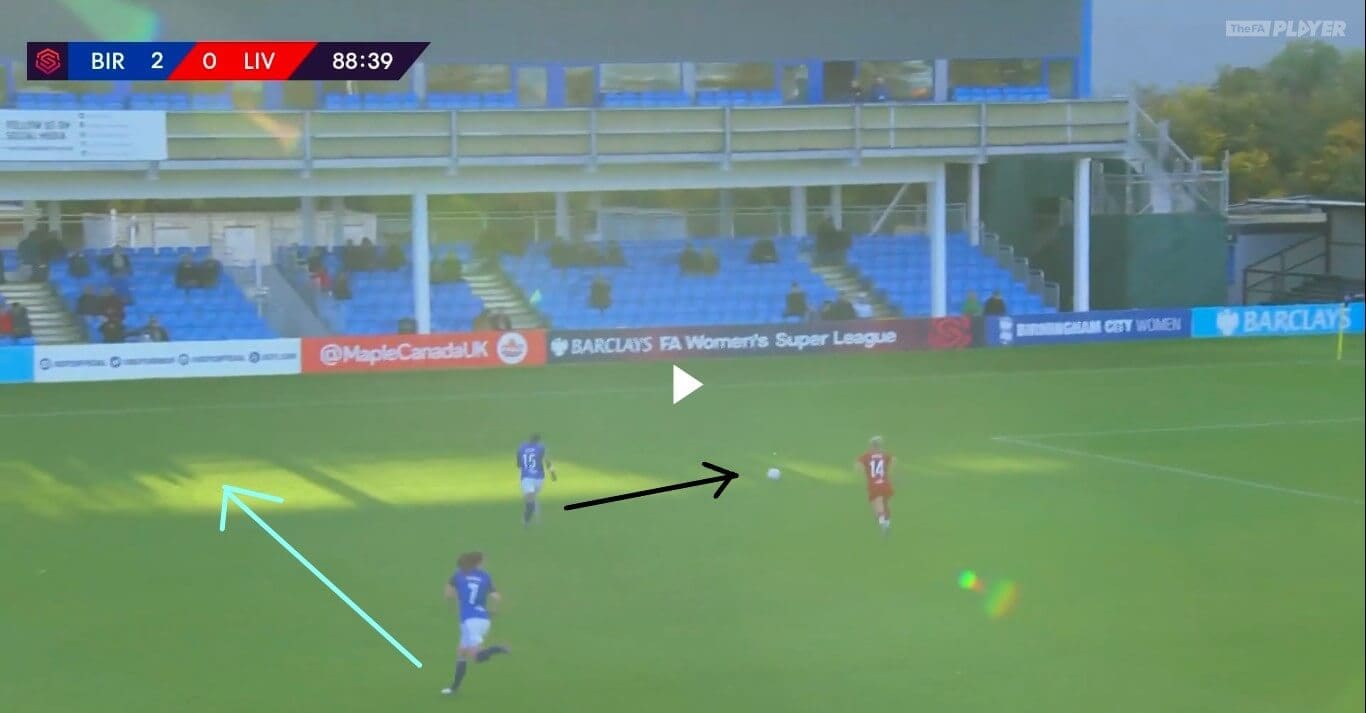
This is late on in the game against Liverpool, but what we can see is that Chloe Arthur has seen how she can move to cover spaces left by her teammates, whilst simultaneously once again offering herself as a passing option. Left-back Adrienne Jordan has advanced forwards, as is very normal, but Arthur has moved to the wing to allow Jordan the freedom to cut inside if she wishes too.
Some of these examples have been brief, but let’s summarise the main points we have raised from this section of the scout report. Chloe Arthur is not necessarily a player who gets into attacking areas of the pitch, and doesn’t want to join in with attacks too much. Instead, she prefers to be the spare player that the ball can come to if it is in too congested an area. This is a very important role to play in the team, and Arthur is able to play it because of her spatial awareness, and so that is how these two aspects of Arthur’s play are linked together.
Her passing
Now, we will complete the picture by looking at how her passing is directly affected by both of these.
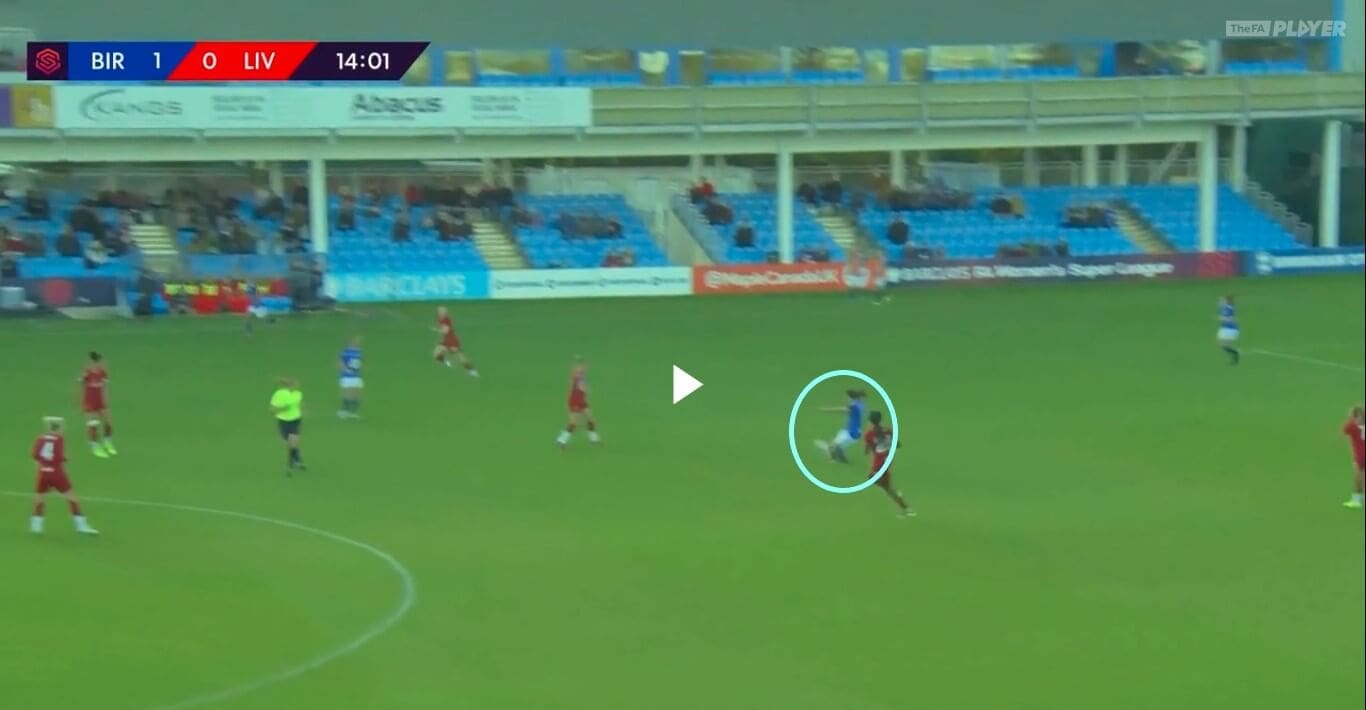
The first point to make about Chloe Arthur’s passing is that she doesn’t necessarily need to be positioned in the middle of the pitch, in order to pass the ball to the attack. She also has the ability to play long passes directly from the defensive areas, and this means she is a threat to opponents anywhere on the pitch, either with or without the ball. That also means that her teammates in the attack don’t have to drop deep at all in order to reduce the distance the ball has to cover, because they know that Arthur is able to find them from anywhere on the pitch.
The second point to make about her passing is that she is able to draw opponents towards her, before making a pass to open up the space for a teammate.

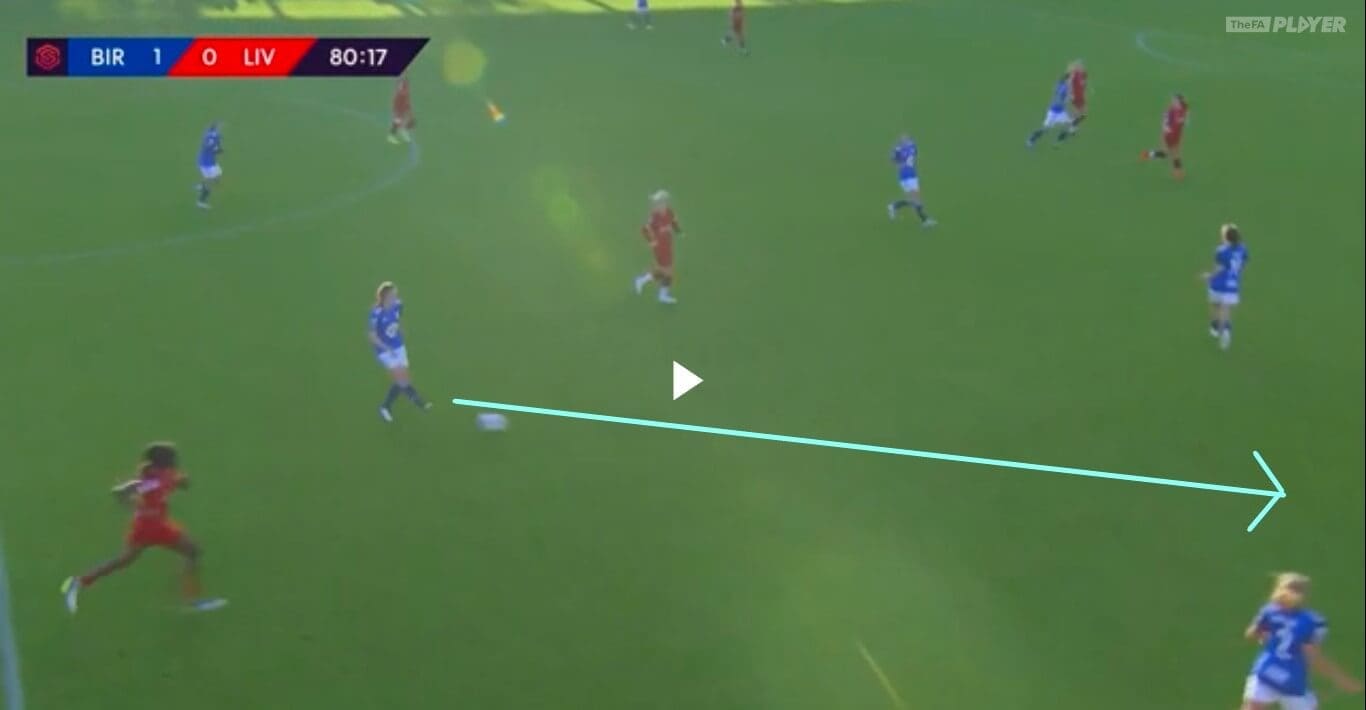
In both of these examples, we can see the diagonal ground passes that Arthur makes. In the first, we can see how Arthur is in the middle of the pitch, and has passed the ball to the wings, where the space is. As we have already mentioned, the Liverpool defenders have already moved towards her, so the space has opened up for Arthur to make the pass.
In the second example, Arthur has not drawn defenders towards her, but the space is still there. We mentioned previously how Birmingham like to play with attacking full-backs, and you can see how the recipient of Arthur’s pass in this image is right-back Sarah Mayling, which shows this point.
You can also see how Liverpool are rushing to get back to cut the pass out, and to block the attack, but the damage has already been done. These two examples show how Chloe Arthur’s passes have come from her spatial awareness and her positioning, so we can see how the three themes all link to each other.
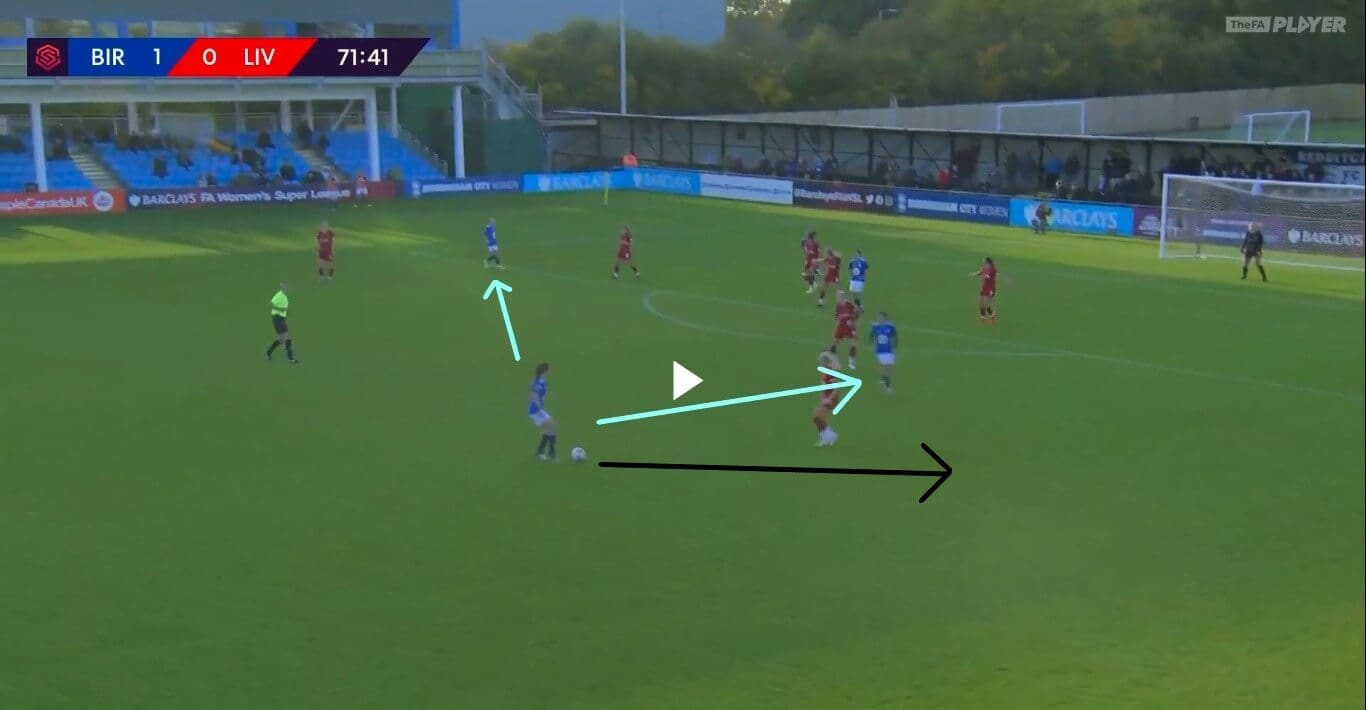
The other thing about her passing is that she opens up options for herself with her positioning. We can see in the image above that, by positioning herself outside of the goal area when Birmingham City Women are attacking, she is able to directly influence her team’s play.
In the image, the blue arrows show the passes she could now make, and the black arrow shows the option she did take in this situation. You can see that she is trying to create attacking opportunities, drawing defenders away from the goal area, allowing Birmingham to position themselves ready for any potential cross.
So what is clear is that Arthur’s passing is another important element of any Birmingham City Women attack.
Possible Improvements
However, her passing does still need some work at times, and particularly her decision-making with which pass to make.
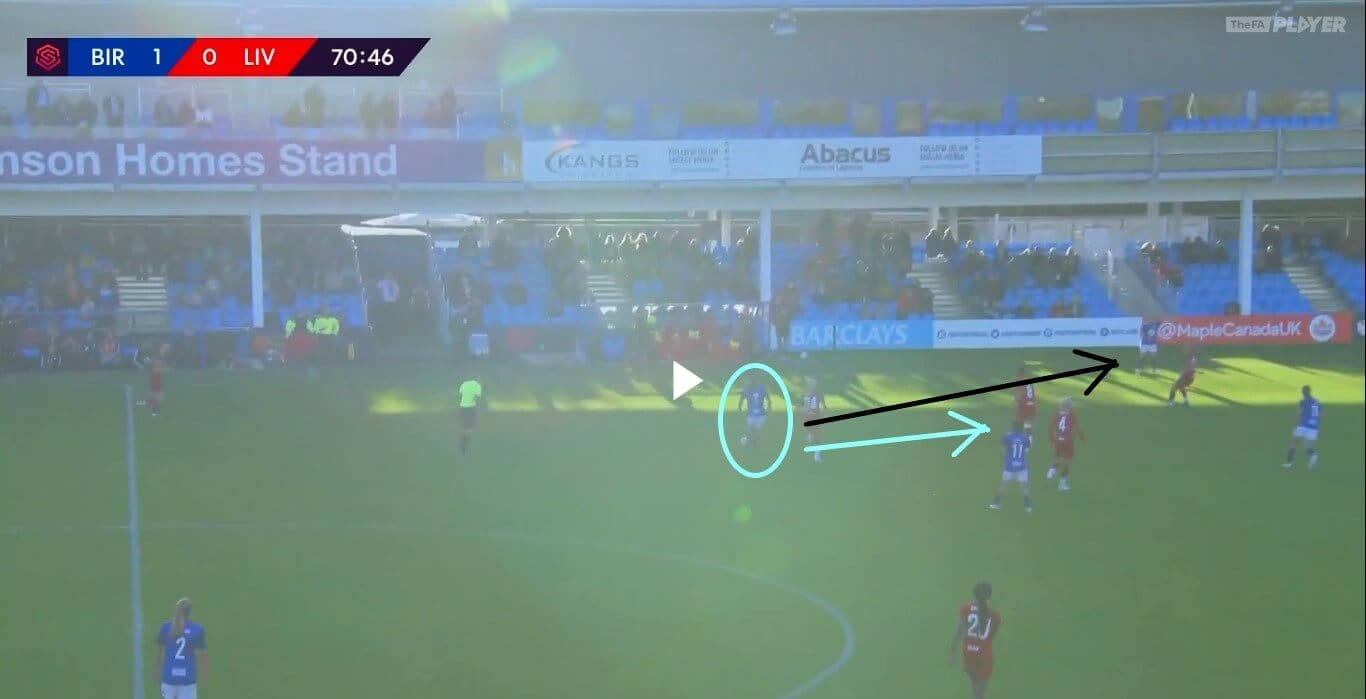
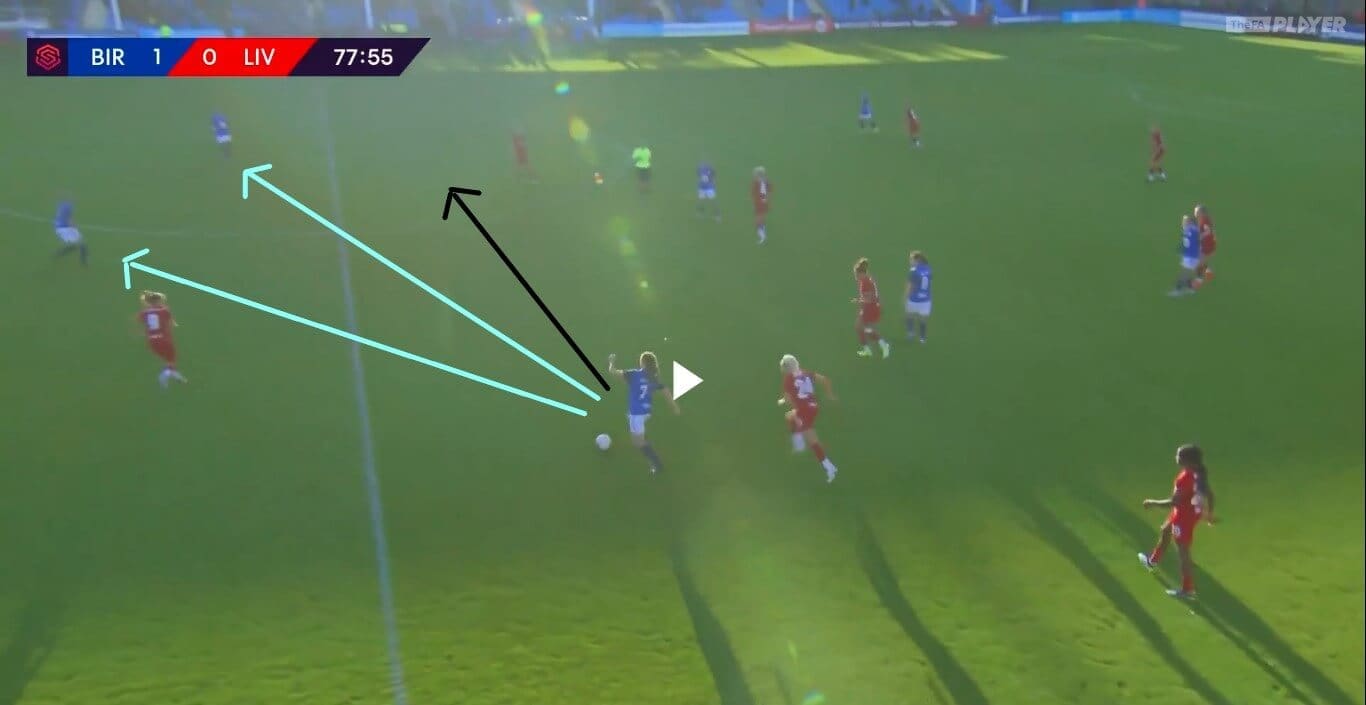
What we can see in both of these images is where Chloe Arthur made the wrong decision in passing the ball. Like the previous example, the blue arrows show her options, whilst the black arrow shows the pass she opted to make. In both of these situations, Liverpool were able to intercept the ball and stop the Birmingham attack.
However, had Arthur opted to take another option with her pass, then it’s possible that Birmingham could have advanced further in both of these situations. The first pass was not in space, but the second one would have been. However, most of the time she does pass accurately, so these are very minor improvements she could make to her play, yet they can still be made, and it would make her an even better player than she already is.
Conclusion
To conclude, what we can see is that Chloe Arthur is a hugely important player for Birmingham City Women. Through analysing her spatial awareness, her positioning and her passing in turn, and seeing how all three are directly influenced by another in that group, we have seen how Arthur’s all-round game helps influence Birmingham’s tactics. There was a good deal of worry when Birmingham lost Ellen White to Manchester City Women last summer, but they do have a good attacking quartet in Lucy Whipp, Abbi Grant, Rachel Williams and Claudia Walker, along with Lucy Staniforth operating among them too. But what is almost certain is that Birmingham would not be able to play the way they do without Chloe Arthur doing the things she does, allowing them to play with the freedom they do.





Comments